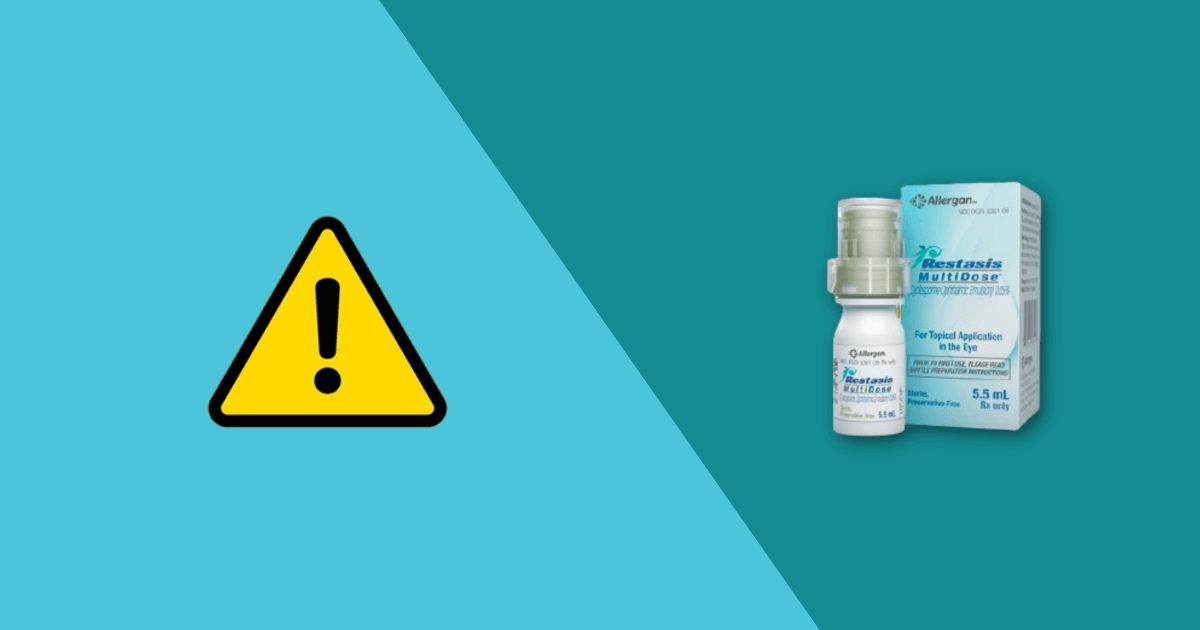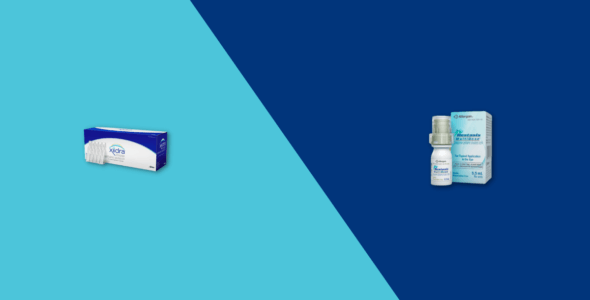Restasis side effects and how to avoid them
Table of contents
Restasis is a brand-name medication manufactured by Allergan Inc. It is classed as a topical immunomodulator used to increase the production of tears in patients who have eye swelling. While Restasis is generally well tolerated, there are some potential side effects that people should be aware of. The most common side effects of Restasis include eye pain and problems with vision.
Learn more about the side effects of Restasis and what you can do to avoid them.
What is Restasis (cyclosporine)?
Restasis eye drops are used to treat chronic dry eye disease (dry eye syndrome) that may be caused by inflammation. It is a topical immunomodulator used to increase tear production in patients whose tear production is suppressed due to ocular inflammation (in the eyes and tear ducts) associated with keratoconjunctivitis sicca. Increased tear production was not seen in patients currently taking topical anti-inflammatory drugs or using punctual plugs. Restasis is not approved for the treatment of blepharitis (eyelid inflammation).
Restasis dosage
Restasis is available as cyclosporine ophthalmic emulsion, containing cyclosporine 0.5mg/mL. It comes in single-use vials and Restasis multidose which comes in a bottle that can be used multiple times.
Instill one drop of the ophthalmic emulsion twice a day in each eye, every 12 hours. The single-use vial has to be thrown away after you use it, as the vials don’t contain any preservatives.
Wait at least 15 minutes before using artificial tears, or any other eye drops. Do not touch the dropper on any surface, including the eyes or hands. The dropper is sterile. If it becomes contaminated, it could cause an eye infection. Also, to avoid potential eye injury and contamination, be careful not to touch the vial tip to your eye.
Do not use this medicine while wearing contact lenses. Contact lenses may be reinserted 15 minutes following the administration of Restasis eye drops. Store at room temperature away from moisture and heat. Do not freeze. Keep the bottle tightly closed when not in use.
If you miss a dose, use it as soon as you remember. If it is almost time for the next dose, skip the missed dose. Use your next dose at the normal time.
You are advised to read the medication guide provided with this medicine for the drug information and patient information, and always speak with your healthcare provider for medical advice about any changes to your dose so they can monitor and evaluate your condition. If you think you’ve taken too much of this drug, call your doctor or call the American Association of Poison Control Centers at 800-222-1222.
Restasis side effects
The most common possible side effects of Restasis include:
- Ocular burning sensation
- Eye redness
- Itchy eyes
- Discharge, watery eyes
- Blurred vision
- Eye pain, eye irritation, foreign body sensation
If you experience more serious side effects, stop taking Restasis and seek medical attention immediately. You are encouraged to report the adverse effects of prescription drugs to the FDA. Visit www.fda.gov/medwatch, or call 1-800-FDA-1088.
Restasis drug interactions
Restasis can interact with other medications including:
- Ophthalmic treatments for glaucoma – betaxolol, levobunolol, timolol
- Steroid eye treatments – dexamethasone, prednisolone
Before taking Restasis, be sure to tell your doctor about all of the medications you are taking to ensure they are safe to take at the same time.
Restasis warnings & precautions
Don’t take Restasis if you:
- Are allergic to the active ingredient cyclosporine
- Have had an allergic reaction to any of the other ingredients in Restasis
Talk to your doctor before using Restasis if you:
- Are taking any of the medications that could interact with Restasis
- Are pregnant or are planning to become pregnant
- Are breastfeeding or are planning to breastfeed – It’s not known if Restasis passes into breast milk
You should always check with your doctor or pharmacist before taking any medication, including Restasis, to make sure it is safe for you.
How to avoid Restasis side effects
The best way to avoid side effects is to take Restasis as directed by your doctor. Follow your doctor’s instructions carefully and do not take more or less than prescribed.
If you experience any side effects, talk to your doctor or pharmacist. They may be able to recommend ways to help reduce or prevent some of the side effects.
1. Stick to the recommended dosage
Take your prescribed dose of Restasis that has been recommended by your healthcare professional. Do not take more or less than prescribed.
2. Monitor your blood sugar levels
Dry eye syndrome is a common problem associated with type 1 and type 2 diabetes. High blood sugar can cause nerve damage in your eyes leading to decreased tear production. If you have diabetes, it is important to monitor your blood sugar levels closely while taking Restasis. Check your blood sugar levels as directed by your doctor and report any changes to your doctor immediately.
3. Drink plenty of fluids
Drink eight to 10 glasses of water or fluids every day to help prevent dehydration, which can make side effects worse.
4. Avoid alcohol
Alcohol is not known to interact with Restasis. However, drink alcohol in moderation as excessive alcohol consumption is known to cause health problems such as heart disease.
5. Don’t skip meals
Eating regular meals and snacks will help to prevent low blood sugar levels (hypoglycemia).
6. Check your feet
If you have diabetes, check your feet for any cuts, sores, or redness regularly. Tell your doctor if you experience any problems with your feet while taking Restasis.
7. Know the signs and symptoms of Restasis side effects
Signs and symptoms of side effects include blurry vision and eye pain. If you experience any of these symptoms speak to your doctor for medical advice.
8. Monitor your weight
Restasis may cause weight gain. This is more common in females over the age of 60, that have been using Restasis for less than 1 month. If you experience weight gain while taking Restasis, get medical advice from your doctor.
9. Tell your doctor about all medications you’re taking
Be sure to tell your eye doctor about all other medications you’re taking, including over-the-counter drugs, vitamins, and herbal supplements, as they can interact with Restasis.
10. Get regular medical check ups
It is important to get regular medical check ups and monitor your medical conditions. Your doctor will monitor your side effects and may adjust your dose of Restasis as needed.
Medically reviewed
A medical professional has reviewed this article.


Jamie Winn, PharmD
Jamie Winn, PharmD
Dr. Jamie Winn received his Doctor of Pharmacy in 2002 from the University of South Carolina College of Pharmacy, Columbia, SC. Jamie is a medical reviewer for NiceRx.



